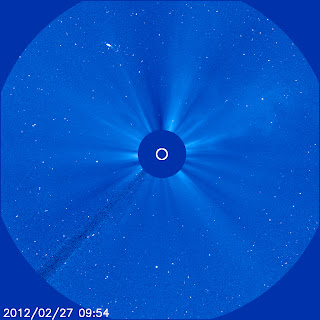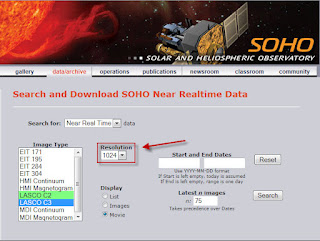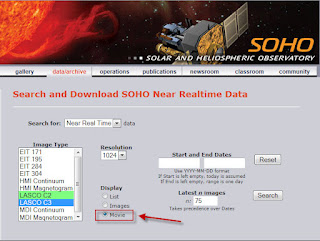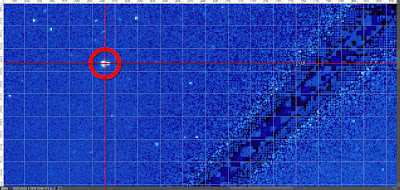 |
| Photo Courtesy: NRL/Sungrazer |
Today we dive into Sungrazer...a real-time citizen science project for discovering new comets. This NASA project has been extremely successful and has cataloged nearly 2,000 comets over the last fifteen years.
All it requires is some patient observation and access to standard photo-editing software most computers already have pre-installed.
This gem of a project has identified almost half of all known comets...all thanks to the dedication of citizen scientists just like us.
Everything is based on the SOHO (SOlar and Heliospheric Observatory) satellite parked in a stable Lagrange point orbit where the Sun and Earth's gravity cancel each other out. Here it can stare at the sun continuosly collecting data. Mainly it focuses on solar flares, jest of plasma gas shooting out from the sun which impacts the solar wind and causes the Aurora Borealis (among other effects). To gather data from a souce so bright, the satellites use an "occulting disk" which covers the body of the sun and blocks out the main solar light, while letting in light from the sun's surfact and out into space. This is the black dot in the center of all the images you'll see (like the one below).
 |
| Photo Courtesy: SOHO and OpenScientist.org |
Although designed to study the sun, SOHO is also perfectly designed for catching comets. As these wanderers near the sun the warmth melts the comet's core and creates the long tail we are all familiar with. The sun's light also illuminates the comet and it's tail to the brightest level they will be. So the SOHO cameras can capture this light and users can watch for the tell-tale white dot moving across the star field.
Sungrazer is also unique in that it is both highly complex AND accessible all at the same time. Yes, it uses raw satellite footage and requires users to manipulate data feeds. It also requires a lot of practice to learn and enough patience to find a needle in a haystick. But the tools are available and it does not take much time to learn. So if you are up for the challenge and want the bragging rights to say you find a never-before known comet, this one is for you.
Getting Started is Easy:
- Visit the SunGrazer web site to learn more about the project and links to all the information you need to know about the project. This includes basic information on comets and the SOHO satellite gathering images for us.
- Read the Official Comet Hunting Guide for information on what to look for. They'll teach you how to differentiate comets from the background stars and planets (stars and planets all move horizontally from left to right; comets appear to move against that flow). They'll also teach you to ignore gamma ray strikes...blips and streaks that randomly appear and may look like comets but are just random blips in the data.
- Once you feel comfortable with the basics, visit the SOHO Realtime Data Portal to download the most recend data and start your observations.
- The first thing you need to decide is which camera to use. The C2 and C3 cameras are most often used by comet hunters. For our purposes the main differneces are the color/clarity of the image and he number of stars/planets visible. I've highlighted both for you below:
 |
| Photo Courtesy: NASA/SOHO and OpenScientist.org |
- Next we need to make sure to use the highest quality images. Make sure to set the resolution to 1024.
 |
| Photo Courtesy: NASA/SOHO and OpenScientist.org |
- For this first pass at the data, we want to create a movie of all the combined images. This helps our eye pick out a moving comet and differentiate it from the other starrs/planets in the image.
 |
| Photo Courtesy: NASA/SOHO and OpenScientist.org |
- To finish out this part, we need to decide the number of images to use in the movie and click "Search". You want to select a number that will give you a reasonable amount of data to go through in the movie without being so long you can't rewatch it multiple times. Comet-hunting takes careful observation and you don't want to miss something, so run the film on a loop multiple times.
 |
| Photo Courtesy: NASA/SOHO and OpenScientist.org |
- Congratulations! You've just completed part 1 and created a movie of the images. They should like one of the two sample movies I've made for you below.
- Watch the movie loop...quickly at first to look for potential comets, then slowing it down to make sure they aren't stars/planets or cosmic rays. You also want to make sure they appear in at least five images to ensure the comets you're tracking are real. I've highlighted the faster and slower boxes for you below.
 |
| Photo Courtesy: NASA/SOHO and OpenScientist.org |
- You're doing well...but don't stop now! Next we need to find the positions of the comets so we can accurately report them to others. There are many tools out there to do this but I chose PhotoShop Elements 10. It's the most current version, is widely available, and costs less than $75 (on Amazon.com or on Adobe.com).
- Find the images with your suspected comet and use the query tool above to download those individual image files. Open them in Photoshop Elements, select the first image, and click on "Edit Photos". This will bring up the edit screen.
- Enable a ruler by selecting "View" from the top navigation bar and then select both "Ruler" and "Grid".
- Zoom in on the target star. Using the gridlines and ruler, determine the x- and y-axis location of the suspected comet as shown below (note the red crosshairs are just for illustration).
 |
| Photo Courtesy: NASA/SOHO and OpenScientist.org |
- Once you have times and coordinates for at least five images, you need to check that they are actually the same body moving at a constant rate (in other words, make sure it follows the laws of physics!) So you need to calculate a speed along the x-axis and y-axis for each pair of obserations by finding the difference (in pixels) between each observation and divide by the time elapsed. In other words...imagine a comet at 9:00PM (100 pixels, 560 pixels), 10:00PM (200 pixels, 580 pixels), and 10:30PM (250 pixels, 590 pixels).
- Over the first hour the comet travels 100 pixels/hour in the x-axis (200-100) and 20 pixels/hour in the y-axis (580-560).
- In the second interval, the comet travels 50 pixels/half-hour in the x-axis (250-200) and 10 pixels/half-hour in the y-axis (590-580).
- Over the same period of time (1-hour), both images would have moved 100 pixels/hour in the x-axis and 20 pixels/hour in the y-axis.
- They match!
- All you need to do now is report it. Just go to the report form and enter the time for each image wth a comet, x/y coordinates for each image, and the SOHO camera used for the observation.
- That's all there is to it!
I realize this has been a long post. The project pulls different types of data, requires lots of film watching, uses different software programs, and even requires some math. But the rewards are worth it for those with the desire to find their own comets. And it's really not that hard. Just go through the process above step-by-step and it should become pretty easy. I've tried to make it as straightforward as possible by highlighting ways the average user would participate. Thought I'm sure astronomers have more sophisticated tools than we do, that doesn't mean everyday people can't make exciting discoveries.
Let's show them what we can do!








NICE Artikel
ReplyDeletebandar togel
Agen togel
togel online
togel online terpercaya
buku mimpi togel
bandar togel terpercaya
main togel
These dealers generally utilize charge card preparing, influencing a vendor to loan program an extraordinary subsidizing open door for them.Cash Advance Lemon-Grove
ReplyDeleteINDEPENDENT CALL GIRLS
ReplyDeleteESCORT
ESCORTS
FEMALE ESCORTS SERVICE KOLKATA
KOLKATA FEMALE ESCORTS SERVICE
INDEPENDENT ESCORTS SERVICE
INDEPENDENT ESCOTRTS SERVIC KOLKATA
KOLKATA INDEPENDET ESCORTS SERVICE
RUSSIAN ESCORTS SERVICE KOLKATA
RUSSIAN ESCORTS SERVICE
KOLKATA RUSSIAN ESCORTS SERVICE
FOREIGN ESCORTS SERVICE IN KOLKATA
INDEPENDEN FOREIGN ESCORTS SERVICE
ESCORT FOREIGN SERVICE IN KOLKATA
SEXY FEMALE ESCORTS SERVICE
SEXY MODEL ESCORTS SERVICE
MODEL ESCORTS CALL GIRLS
MODEL ESCORTS CALL GIRLS SERVICE KOLKATA
CALL GIRLS SERVICE KOLKATA
CALL GIRLS IN KOLKATA
KOLKATA CALL GIRLS
KOLKATA CALL GIRLS
CALL GIRLS KOLKATA
CALLL GIRL kolkata
FEMALE CALL GIRLS KOLKATA
FEMALE CALL GIRLS
SEXY CALL GIRLS SERVICE IN KOLKATA
ESCORTS SERVICE IN KOLKATA
I was very pleased to find this web-site. I wanted to thanks for your time for this wonderful read!! I definitely enjoying every little bit of it and I have you bookmarked to check out new stuff you blog post.
ReplyDeleteHome Ground
Homeland.edublogs.org
There is no right time to ask your customers about referrals. There is no point in limiting yourself and asking incomplete, shy questions. If you have given an efficient service then it's all the confidence you need to ask those questions.guzel sozler
ReplyDeleteDelhi Escorts Service Call now 9810927890
ReplyDeleteWe must secure our everything escorts and Services as a private and scholarly movement that we do make are not just cleanliness to certain the Independent chanakyapuri Escorts and Independent Delhi Escorts of your decision will give the most real. We had a gathering of extremely refined and affirmed Green Park Escortsand young pleasures that not simply you should live with remarkable conditions. Like millions, you can rely on us for that where your everything sort of want and dreams come in genuine with hot hauz khas Escorts. It is safe to say that you are a representative and are intending to take an aerocity escorts? Be that as it may, directly on, in light of the fact that we don't make any talking with any client with us, the upkeep given by Connaught Place escortsService is particularly It is awesome.
Hence, this is all about the escort booking online services for the customers and if you are thinking to find a person
ReplyDeletewho is really rocking and pleasure-based for you then just start a new meeting with Russian Escorts in Mumbai for the hotter engagements and possibilities of sex.
Mumbai Escorts
Escorts in Mumbai
Mumbai Call Girls
we want to approach the appropriate BSNL CSC for necessary payment receipts, but now ISP allows customers to download any type of postpaid bill receipt through selfcare portal login. BSNL Bill Payment Receipt To do so, you must first have a registered account in the advanced portal, and then you must add your billing account with the BSNL customer ID assigned to you to get your BSNL bill paid receipt.
ReplyDelete